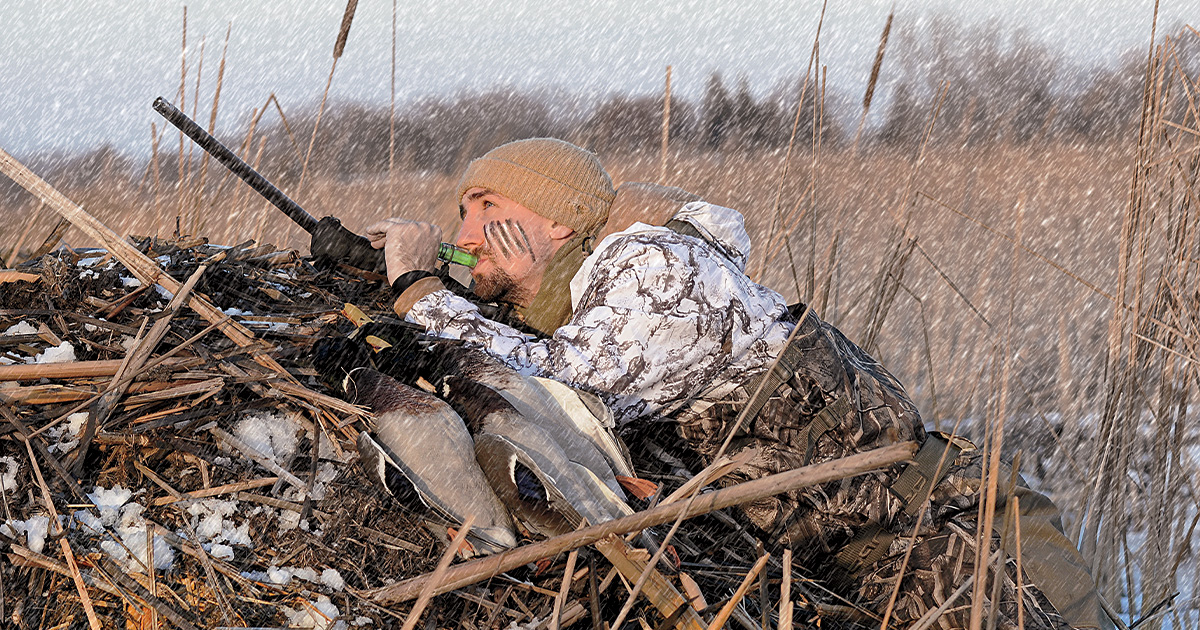Waterfowler's World: Snow Days
When you’re hunting spooky late-season birds, the white stuff can be a game-changer
When you’re hunting spooky late-season birds, the white stuff can be a game-changer

By Bill Buckley

LET IT SNOW : For success on snowy hunts, pay extra attention to your concealment and use loud, aggressive calling.
Snow days can provide some phenomenal waterfowling opportunities. When snow is falling, waterfowl tend to get nervous and become focused on finding food. This makes them more vulnerable and apt to come in on the first pass if your setup is right. Scott Threinen, a champion caller and owner of Molt Gear in Rochester, Minnesota, says that if you adjust your tactics a bit, snow days can be a great equalizer when hunting educated birds.
Because a bird’s long-distance vision can become impaired in falling snow, movement is crucial to drawing the attention of ducks and geese, Threinen says. When duck hunting on snowy days, he uses lots of spinners. And for both duck and goose hunting, he says that black goose flags are extremely effective. Typically, the heavier the snow, the more visibility you need. For ducks over water, Threinen recommends using oversized decoys as well as high-contrast species like black ducks and Canada geese. The name of the game is to stand out, so don’t forget to dunk your dekes if they start accumulating snow.
When field-hunting geese in snow flurries, Threinen might use lots of full-bodies, but if the forecast calls for heavier snowfall he’ll pare his spread back. “Fewer decoys that you can keep clean of snow will be far more effective than lots of snow-covered ones,” he says. “Again, it’s all about being visible. I’ll often use silhouettes anytime I can get them in the ground. While the upwind side of a silhouette will collect snow, the downwind side—where the geese are coming from—will remain snow-free.” Silhouettes can also augment your full-body spread. Threinen recommends separating the two styles, placing full-bodies where you want the geese to land and silhouettes farther upwind.
A snow-covered landscape can present serious challenges for hunters trying to hide from sharp-eyed waterfowl. Hunting over water presents fewer concealment issues than field hunting does. “I don’t make any allowances for snow on water hunts since we’re not set up inside the spread and our blinds are out of the birds’ line of sight,” Threinen explains. “As long as you brush your blinds to match the surrounding cover, accumulating snow won’t be an issue.”
Field hunting for geese is a different matter. “Earlier in the season I might set up layout blinds inside a field spread,” Threinen says. “But by the time snow flies, the geese are already pretty wary. Typically, my buddies and I will set up farther away from the spread as the season progresses and the geese get smarter. We’ll take advantage of natural cover along field edges and, where possible, stay out of the birds’ line of sight. I’m not a big believer in snow covers—I’ve never used any that really matched the snow conditions perfectly. We’ll typically cover the lower half of a blind with snow and brush the top half.”
Success also hinges on reducing as much sign of human activity as possible. When entering a field, Threinen will drive or walk in from the upwind side of the setup, avoiding any disturbance in the spots where he wants birds to land. He also uses brooms and rakes to smooth over tire tracks and footprints and regularly picks up spent hulls. Even in heavy snow, attention to detail is critical. As Threinen says, “Late in the year, everything you do matters.”
Because falling snow diminishes visibility, loud, aggressive calling will help birds home in on your spread. Threinen doesn’t alter his normal duck calling much in these conditions, other than being louder and more aggressive. But for Canada geese, although he’ll still call aggressively, he uses more moans and bawls versus fast clucks and double clucks. The heavier the snowfall, the more pleading his calls will sound, mimicking what the birds do naturally.
Threinen encourages hunters to get out and hunt anytime snow is in the forecast. “In 29 years of waterfowling, most of my best memories are from days when it was snowing,” he says. “That’s pretty telling, I think.”
Ducks Unlimited uses cookies to enhance your browsing experience, optimize site functionality, analyze traffic, and deliver personalized advertising through third parties. By continuing to use this site, you agree to our use of cookies. View Privacy Policy